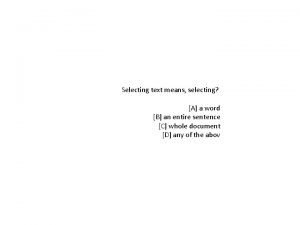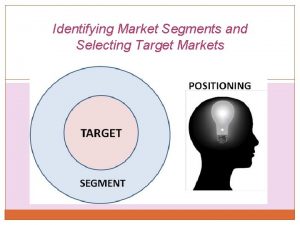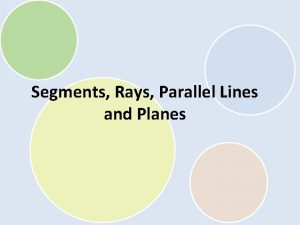10 Identifying Market Segments Selecting Target Markets 9252020

















- Slides: 17

10 Identifying Market Segments & Selecting Target Markets 9/25/2020 1

Chapter Objectives § We focus on the following questions: § How can a company identify the segments that make up a market? § What criteria can a company use to choose the most attractive target markets? 9/25/2020 2

Target Marketing § Target marketing requires marketers to take three major steps: § Identify and profile distinct groups of buyers who differ in their needs and preferences (market segmentation). § Select one or more market segments to enter (market targeting). § For each target segment, establish and communicate the key distinctive benefit(s) of the company’s market offering (market positioning). 9/25/2020 3

Levels and Patterns of Market Segmentation § Levels of Market Segmentation § Mass marketing § Micromarketing § Segment marketing § Market segment § Sector § Flexible market offering § Naked solution § Discretionary options 9/25/2020 4

Levels and Patterns of Market Segmentation § Niche Marketing § Niche § Local Marketing § Individual Customer Marketing § Mass-customization § Choiceboard § Customerization § Segments § Individuals 9/25/2020 5

Levels and Patterns of Market Segmentation § Patterns for Market Segmentation § Preference segments § Homogeneous preferences § Diffused preferences § Clustered preferences § Natural market segments § Concentrated marketing 9/25/2020 6

Basic Market-Preference Patterns 9/25/2020 7

Levels and Patterns of Market Segmentation § Market Segmentation Procedure § Needs-based market segmentation § Market partitioning § Brand-dominant hierarchy § Nation-dominant hierarchy 9/25/2020 8

Levels and Patterns of Market Segmentation § Effective Segmentation § § § 9/25/2020 Measurable Substantial Accessible Differentiable Actionable 9

Segmenting Consumer and Business Markets § Bases for Segmenting Consumer Markets § Geographic Segmentation § Demographic Segmentation § § § 9/25/2020 Age and Life-Cycle Stage Life Stage Gender Income Generation § § § § Depression Cohort World War II Cohort Post-War Cohort Leading-Edge Baby Boomer Cohort Trailing-Edge Baby Boomer Cohort Generation X Cohort Generation Y Cohort 10

Segmenting Consumer and Business Markets § Lifestage Analytic Matrix § Lifestages § Physiographics § Emotional effects § Socioeconomics § Social Class § Psychographic Segmentation § Lifestyle § Time-constrained § multitasking § Money-constrained 9/25/2020 11

Segmenting Consumer and Business Markets § Personality § “Brand personality” examples: § § § Sincere Exciting Competent Sophisticated Rugged § Values § Core values 9/25/2020 12

Segmenting Consumer and Business Markets § Behavioral Segmentation § Occasions § Critical life events or transitions § Benefits § Mobil has identified five segments and their sizes § § § 9/25/2020 Road Warriors 16% Generation F 27% True Blues 16% Home Bodies 21% Price Shoppers 20% 13

Segmenting Consumer and Business Markets § User Status § Usage Rate § Loyalty Status § § Hard-core loyals Split loyals Shifting loyals Switchers § Buyer-Readiness Stage § Attitude 9/25/2020 14

Segmenting Consumer and Business Markets § Multi-Attribute Segmentation (Geoclustering) § Four PRIZM clusters § § American Dreams Rural Industria Gray Power Country Squires § Targeting Multiple Segments 9/25/2020 15

Major Segmentation Variables for Business Markets Demographic 1. Industry: Which industries should we serve? 2. Company size: What size companies should we serve? 3. Location: What geographical areas should we serve? Operating Variables 4. Technology: What customer technologies should we focus on? 5. User or nonuser status: Should we serve heavy users, medium users, light users, or nonusers? 6. Customer capabilities: Should we serve customers needing many or few services? Purchasing Approaches 7. Purchasing-function organization: Should we serve companies with highly centralized or decentralized purchasing organizations? 8. Power structure: Should we serve companies that are engineering dominated, financially dominated, and so on? 9/25/2020 16

Figure 10 -3: Segment-by-Segment Invasion Plan 9/25/2020 17
 Primary target market and secondary target market
Primary target market and secondary target market Selecting text means selecting
Selecting text means selecting Identifying market segments and targets chapter 9
Identifying market segments and targets chapter 9 Segment by segment invasion
Segment by segment invasion Identifying market segments and targets chapter 9
Identifying market segments and targets chapter 9 Single segment concentration
Single segment concentration Identifying market segments and targets chapter 9
Identifying market segments and targets chapter 9 Four levels of micromarketing
Four levels of micromarketing Potential development projects can be identified by
Potential development projects can be identified by Identifying and non identifying adjective clauses
Identifying and non identifying adjective clauses Identifying and non identifying adjective clauses
Identifying and non identifying adjective clauses Identifying and non identifying adjective clauses
Identifying and non identifying adjective clauses International market segmentation
International market segmentation Selecting investment in global market
Selecting investment in global market Selecting investment in global market
Selecting investment in global market Target market and channel design strategy
Target market and channel design strategy Leader challenger follower nicher
Leader challenger follower nicher Common market segments
Common market segments






























